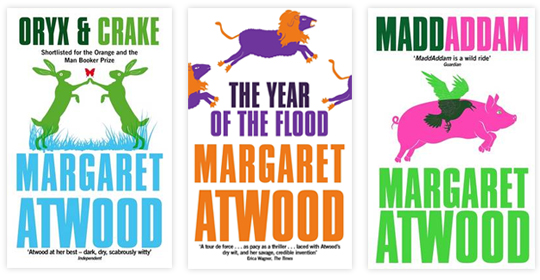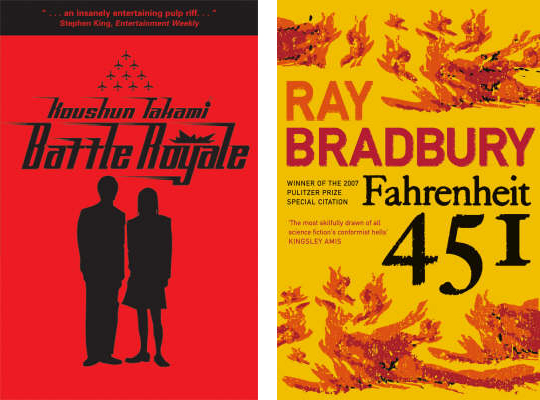re:View – The 2015 Bookshelf
February: the apocalypse and beyond
Perhaps unsurprisingly, January’s reading journey to dystopia has led me on into the apocalypse. I guess the two often go hand in hand – certainly in the case of Maragret Atwood’s MaddAddam trilogy, which forms the central part of my February reading.

Oryx & Crake by Margaret Atwood
Welcome to Margaret Atwood’s apocalypse, starring a man who just may be the last of his kind, a group of people who are somehow not quite human, and a range of animals who are definitely not what they seem. We’re at some point in the later 21st century and the climate has gone haywire, the world lies in ruins and humanity is pretty much done for. As Jimmy goes about his daily routine of surviving and looking after the Children of Crake, with their glowing green eyes and their strange biology, a series of flashbacks takes us through the recent history that has put them all into this bizarre scenario. In a way it’s the history of our future, or in any case one possible future. Faced with the challenges of overpopulation and shortages of supply, man has come quite a long way in playing God, splicing and dicing away in a bid to create better humans, better environments and better food alternatives. The scientific elite lives and works locked away in high-security ‘compounds’ while the masses are crammed into ‘pleeblands’ crawling with disease and danger. At the heart of Oryx & Crake is the story of Crake, a gifted scientist with a vision of humanity’s future so radical, so perfect and yet so hopelessly misjudged that he is about to single-handedly wipe out civilisation. Atwood has described the work as ‘speculative fiction’ rather than sci-fi, saying it contains nothing that hasn’t already been invented. And certainly, once you get into the science behind Crake’s vision, you quickly realise that we’re already seeing the beginnings of it in our own time – the bioengineering, the transhumanism, the attempts to prolong life artificially. Some of the stuff from Crake’s world we have already seen – the lab-grown burger that made the headlines a couple of years ago comes to mind – and when you read this book you get a sneaking suspicion that some of his more terrifying scientific breakthroughs may only lie a few years ahead of us.
Pens: 4 out of 5
The Year of the Flood by Margaret Atwood
This book essentially re-tells the story of Oryx & Crake from the perspective of two new, female characters. While the first part in Atwood’s series offers us glimpses into the segregated, high-security scientific communities and their work leading up to the man-made apocalypse, the second novel takes us outside of these ‘compounds’ into a dangerous urban world where street gangs clash with eco-religious sects such as God’s Gardeners and any resistance to the system is crushed by a military force accountable only to itself. The Year of the Flood tells the story of Toby and Ren, two young women living in a Gardeners community, as they negotiate the fine line between the oppressive security of life under state control and the daily risks of living on the fringes of a dog-eat-dog society. While you know from the start that both women survived Crake’s pandemic that wiped out most of humanity – one sealed up in the quarantine unit of a high-end strip club, the other trapped in a remote mansion surrounded by vicious new types of animals – this book will have you turning those pages trying to figure out whether they will get out of their accidental survival pods – and whether there’s anything left out there worth surviving for. I spent quite a while wondering why I found the second book so much more engaging – until I realised that while Jimmy’s life story in part one is characterised by casual sex as a pastime, the lives of these two women are shaped by sex as a currency, sex as a survival mechanism and abuse as a common risk of daily life. Putting things in perspective: that’s Margaret Atwood for you.
Pens: 5 out of 5
MaddAddam by Margaret Atwood
Having been thoroughly blown away by part two, I found it a bit difficult to get into the final part in the series. MaddAddam picks up the pieces of the previous two books, bringing Jimmy and the not-quite-human Crakers together with the remaining God’s Gardeners and compound scientists as they try to build up a new, post-apocalyptic micro-society and deal with the threats posed by genetically engineered predators and the equally vicious survivors of the street gangs. In this book Adam and Zeb – the founder of the God’s Gardeners and his mysterious outsider brother – take a central role as we learn about their history and the roles they played in the events leading up to the apocalypse. And while the civilisation of the Crakers matures and the younger human survivors start to contemplate the prospect of repopulating the Earth with a cross-breed of ‘optimised’ humans, there is also a price to pay for this new chance, and you start to realise that the time is coming to say goodbye to the characters whose journey you’ve shared. I’m happy to admit that I cried into the final pages of MaddAddam because Atwood makes these three books feel like you’ve spent an actual lifetime with the central characters – and being kicked back out of their world at the end seriously hurts.
Pens: 4 out of 5

Battle Royale by Koushun Takami
The book that inspired The Hunger Games is not for the faint hearted. A group of high school students is deposited on an isolated island for a game that has only one rule: Kill each other until only one survivor is left, or you’ll all be executed wholesale. This cheerful ‘game’ is part of an annual programme run by the totalitarian government of a dystopian future version of Japan. Predictably, much slaughter ensues. But beyond the gore and the graphics , the books explores the various coping strategies of those trapped in the game. Do you team up and bet your life on safety in numbers, hoping that nobody in the group will betray you? Do you rebel against the system and delude yourself with hopeless plots of sabotage and escape? Or do you ditch all faith in mankind and go on a cold-blooded murder spree based on the assumption that everybody else will kill you if given half a chance? This is a story of trust and betrayal, both on a personal level and on the larger scale of the citizen within their nation. I love how Takami analyses the workings of totalitarian terror by delving deep into the psyche of individual characters to explore what makes them tick in this extreme situation. This approach also gives a degree of purpose to the violence and creates a deeper bond with some of the major character, which pretty much throws you into the game as one of them. Shocking, outrageous and immensely exciting, this book really deserves its cult status in literature.
Pens: 4 out of 5
Fahrenheit 451 by Ray Bradbury
Oh well, that was short and weiiird. In this horror vision of a future books are banned – so banned they have to be burned and the fire brigade exists with the sole purpose of burning books along with their owners and their houses. One fireman is happily burning books until one day he meets a strange girl, starts thinking about his job and his marriage, gets curious about books and sets the stage for his own demise – or it might just be his liberation. I can see why this book has earned its position as a classic for its ideas, but it isn’t one I particularly enjoyed reading. I can’t say it wasn’t moving; it certainly got to me – if only by making me rather angry and frustrated. But overall I found the structure and language a little too bare and abstract, making the whole thing feel like a quick and slightly awkward short story rather than a novel that you can really get your teeth into.
Pens: 3 out of 5
